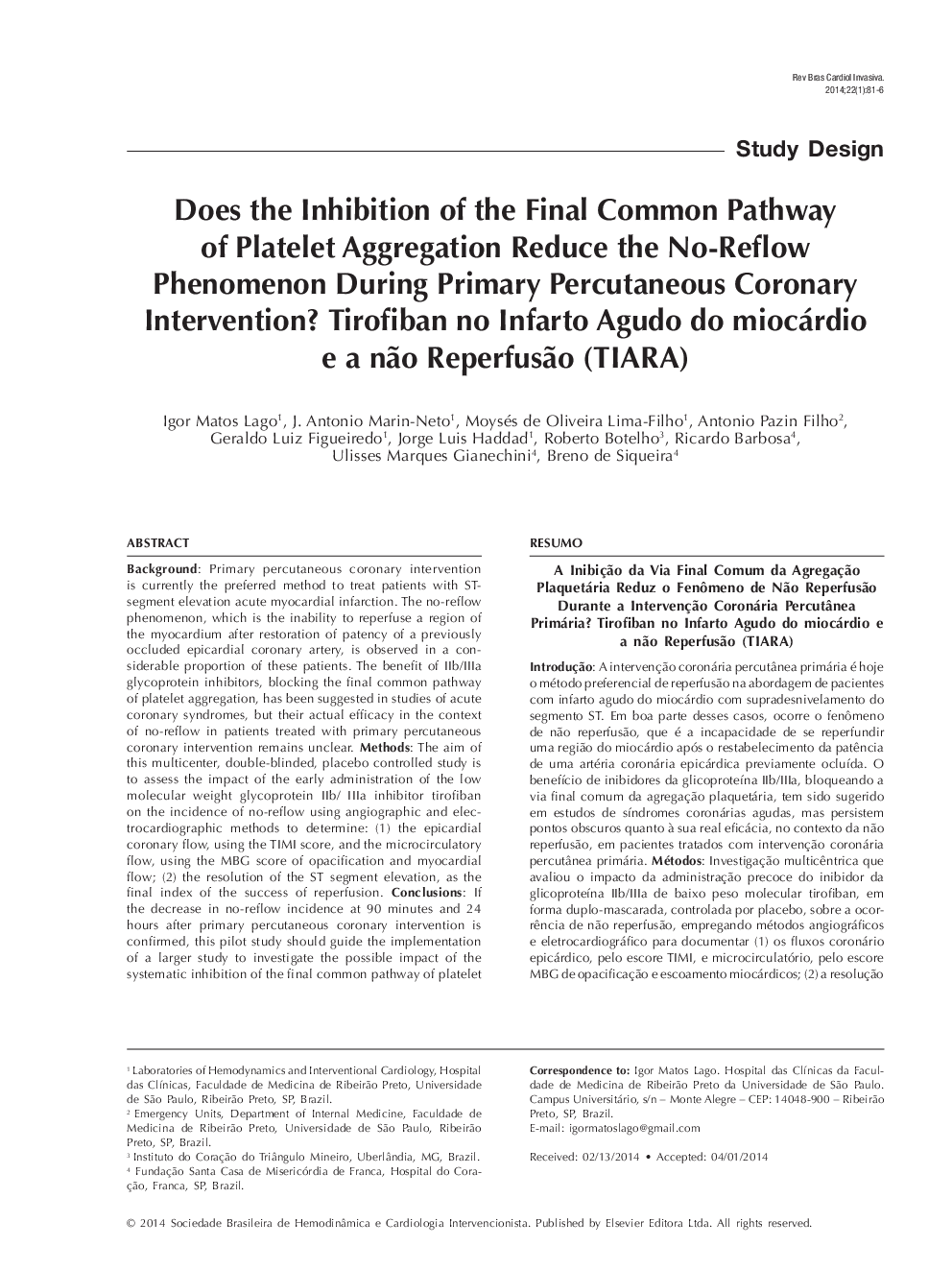| Article ID | Journal | Published Year | Pages | File Type |
|---|---|---|---|---|
| 3011699 | Revista Brasileira de Cardiologia Invasiva (English Edition) | 2014 | 6 Pages |
ABSTRACTBackgroundPrimary percutaneous coronary intervention is currently the preferred method to treat patients with STsegment elevation acute myocardial infarction. The no-reflow phenomenon, which is the inability to reperfuse a region of the myocardium after restoration of patency of a previously occluded epicardial coronary artery, is observed in a considerable proportion of these patients. The benefit of IIb/IIIa glycoprotein inhibitors, blocking the final common pathway of platelet aggregation, has been suggested in studies of acute coronary syndromes, but their actual efficacy in the context of no-reflow in patients treated with primary percutaneous coronary intervention remains unclear.MethodsThe aim of this multicenter, double-blinded, placebo controlled study is to assess the impact of the early administration of the low molecular weight glycoprotein IIb/ IIIa inhibitor tirofiban on the incidence of no-reflow using angiographic and electrocardiographic methods to determine: (1) the epicardial coronary flow, using the TIMI score, and the microcirculatory flow, using the MBG score of opacification and myocardial flow; (2) the resolution of the ST segment elevation, as the final index of the success of reperfusion.ConclusionsIf the decrease in no-reflow incidence at 90 minutes and 24 hours after primary percutaneous coronary intervention is confirmed, this pilot study should guide the implementation of a larger study to investigate the possible impact of the systematic inhibition of the final common pathway of platelet aggregation on the mortality of ST-segment elevation acute myocardial infarction patients.
RESUMOA Inibição da Via Final Comum da Agregação Plaquetária Reduz o Fenômeno de Não Reperfusão Durantea Intervenção Coronária Percutânea Primária? Tirofiban no Infarto Agudo do miocárdio e a não Reperfusão (TIARA)IntroduçãoA intervenção coronária percutânea primária é hoje o método preferencial de reperfusão na abordagem de pacientes com infarto agudo do miocárdio com supradesnivelamento do segmento ST. Em boa parte desses casos, ocorre o fenômeno de não reperfusão, que é a incapacidade de se reperfundir uma região do miocárdio após o restabelecimento da patência de uma artéria coronária epicárdica previamente ocluída. O benefício de inibidores da glicoproteína IIb/IIIa, bloqueando a via final comum da agregação plaquetária, tem sido sugerido em estudos de síndromes coronárias agudas, mas persistem pontos obscuros quanto à sua real eficácia, no contexto da não reperfusão, em pacientes tratados com intervenção coronária percutânea primária.MétodosInvestigação multicêntrica que avaliou o impacto da administração precoce do inibidor da glicoproteína IIb/IIIa de baixo peso molecular tirofiban, em forma duplo-mascarada, controlada por placebo, sobre a ocorrência de não reperfusão, empregando métodos angiográficos e eletrocardiográfico para documentar (1) os fluxos coronário epicárdico, pelo escore TIMI, e microcirculatório, pelo escore MBG de opacificação e escoamento miocárdicos; (2) a resolução do supradesnivelamento do segmento ST, como índice final do sucesso da reperfusão.ConclusõesSe comprovada redução da incidência de não reperfusão tanto 90 minutos como 24 horas após a intervenção coronária percutânea primária, este estudo-piloto, deve nortear a implementação de estudo mais abrangente, para investigar o possível impacto do bloqueio.
